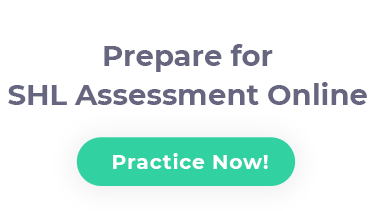SHL’s Situational Judgment Tests (Scenarios Assessments) Online Preparation for Graduates, Managers & Executives

What Is SHL’s Situational Judgment Test?
SHL is a well-known assessment company who has been tinkering with and perfecting their situational judgment test for years. A situational judgment test, or SJT, is a behavioral test designed to evaluate the personality of a candidate to see if they align with a company’s values and standards. It also serves companies by discerning the leadership style, teamwork abilities, and communication skills of candidates.
The SJT is an assessment that may be used in pre-employment screenings, training exercises, and other selection processes. SHL has developed the test to come in three versions suited for different levels of expertise, however, each test applies to any line of work.
Although each version differs slightly, there are a few commonalities. First, each test has a series of scenarios accompanied by four to six follow-up questions and statements. The candidate must rank how much they agree with the statement on a six-point scale. Additionally, both the managers and executives are graded on the same subsets:
- Managerial Judgment
- Managing Objectives
- People Management
- Reputation Management
Further, each assessment is untimed. This is an important feature of the test because it gives candidates the option to make their decisions quickly or think through them.
Graduate
Graduates entering the workforce are subject to different SJT’s than managers and executives due to their lack of work experience. For this reason, the hypothetical scenarios that the graduates will encounter may be slightly more general and use less workplace context. Similarly, graduates are tested on differentiating subsets as well which include people management, corporate management, and managing objectives rather than judgment and reputation.
Graduates taking SHL’s situational judgment test will be given fourteen scenarios with seventy follow-up questions and statements. While the test is not timed, it usually takes candidates about twenty-five minutes to complete the assessment.
Manager
In addition to the aforementioned subsets, the SJT for managers also appraises the management style of the candidate. They will be rated and given feedback for each of the following approaches:
- Big Picture
- Delegating & Assigning
- Following Company Practices
- One-on-One
- Personal Recognition
- Team Oriented
Candidates will have sixteen scenarios to evaluate throughout one hundred questions. The average test-taking time for the manager scenarios version is forty minutes.
Executive
Executives have one of the more difficult SJT’s because they are given an array of complicated scenarios to work through. This is done by SHL to highlight the leadership abilities of candidates. SHL also makes predictions of the management approach of candidates and aligns them with these six styles:
- Using Outside Help
- One-on-One
- Commercial Support
- Organizational Support
- Workforce
- Leading & Handling the Work
This information is discerned from sixty questions regarding twelve scenarios. Candidates can work at any pace they choose, but the average test-taking time for executives is half an hour.
How Is the SHL SJT Scored?
Grading the situational judgment test is somewhat difficult because all of the answers are discretionary and, in some cases, there are no wrong or right answers. This is why SHL has used experts to formulate a test where some questions have multiple right answers; however, each answer offers the company a tell as to how you behave in the workplace and how you get along with coworkers.
This somewhat complicated manner of grading is why your score is produced in four different numbers, each with a different meaning. One is a subset scale. This will layout the letters from A to E, with A being the highest, and rate your success in these areas. For example, if you achieved a “B” in People Management, that would tell the company that you are fairly effective in handling team issues, managing your staff, and that you can take on a group of direct reports.
Next, the report will move on to the leadership styles with some tips on what you need to improve. This could be a range of things from consulting others to prioritizing some things over others. These will also be rated on a scale from A to E with the meanings of each on either end.
Then, there is the percentile score. This takes a candidate’s raw score and measures it against a comparison group. The comparison group will be an accumulation of the scores of likeminded individuals at the same level of experience. The percentile is an indication of how well a candidate performed in comparison to their peers. So, for example, if you are in the 90th percentile, you performed better than 90% of people who took this assessment. This score is weighted the heaviest.
Lastly, there are the T-scores and sten scores. Sten stands for standard ten and takes the population of scores and their standard deviation into account to produce a number in this area. The T-scores set somewhat of a standard and maintain a mean of 50 with ten increments representing a shift in standard deviation. These are more of a formality and are not of high consideration when looking at the various scores.
How Can I Prepare for SHL’s Situational Judgment Test?
Preparing for the SJT may seem kind of impossible because the questions gear more toward personal preference and opinions rather than factual data. However, the SHL has created what they call “ideal answers” that set a standard for the candidates. This also means it would be wise to put some time and effort into your preparation for this exam.
The best first step would be to visit the website of the company you work for or are applying to and read over their values. This will tell you exactly what they look for in a candidate and a leader. You can use this as a guideline for your SJT and try to see how well you align with these values.
After you have done this, run through some online practice assessments. These will acquaint you with the type of scenarios you’re bound to run into during your SJT. From there, you will be able to see what they’re looking for in terms of answers. This will also allow you to track your progress, so you can be at your very best when it is time for you to take SHL’s situational judgment test. Best of luck!
Disclaimer: SHL® is a registered trademark of SHL Group Ltd. SHL Group Ltd is not affiliated with Practice4Me or this website. This website solely provides information on how to prepare for job psychometric tests.

